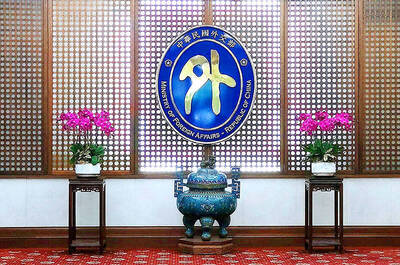A revised version of the draft media monopolization prevention and diversity bill is to be unveiled by the end of the month, the National Communications Commission (NCC) said yesterday, adding that the commission also plans to amend the Radio and Television Act (廣播電視法), the Cable Radio and Television Act (有線廣播電視法) and the Satellite Broadcasting Act (衛星廣播電視法).
The draft act on media monopolization in 2013 secured preliminary approval from the legislature’s Transportation Committee, following a series of protests against media monopolization.
Before the bill received final approval, the Cabinet last year retracted it from the legislature.
The commission decided to revise it because the media industry has undergone significant changes since 2013, including the rise in popularity of over-the-top content providers, NCC Chairwoman Nicole Chan (詹婷怡) said.
“The public remains concerned that the concentration of media ownership could compromise the diversity of public opinion. Therefore, we decided to propose a revised version of the draft,” she said.
While drawing up the bill, the commission consulted the draft passed in 2013, as well as other bills proposed by the Democratic Progressive Party and the New Power Party, Chan said.
“We plan to spend one or two more months listening to feedback from the public after the bill is made public with the goal of submitting it to the Cabinet by the end of the year,” she said.
The bill is expected to be deliberated in the legislative session scheduled to begin in February next year, she said.
The media monopolization bill and the amendments to the three broadcasting acts should not be handled separately, because they all affect the development of the broadcasting industry, Chan said.
The monopolization prevention bill lists structural guidelines governing the review of media mergers, Chan said, adding that such deals would be banned if they cross “red lines.”
“We will also assess whether the transactions affect national security, the public interest or the development of the media industry, which we call ‘yellow lines,’” she said, adding that the commission has yet to finalize the definitions of “red lines” or “yellow lines.”
Regarding the amendment of the three broadcasting acts, Chan said that the commission would address issues stemming from regulations banning political parties, the government and the military from investing in media outlets.
So far, media outlets have not yet found effective ways to prevent political parties, the government and the military from buying their stock.
Rather than holding political parties, the government and the military accountable for buying shares in media outlets, current regulations punish media outlets that have sold stock to such entities, whether knowingly or not.
It is the commission’s job to truthfully represent the “status quo” to the legislators, Chan said.
“The commission is legally bound to adhere to a principle that prevents the intervention of the government, political parties and the military in media outlets and we should consider the most effective ways to enforce the principle, including if shares owned by the government or political parties in the media outlets should be limited to certain percentages,” she said.
“We should also consider whether to keep punishing media companies, rather than the political parties or the government, for buying shares in media outlets,” she said.

The Ministry of Foreign Affairs (MOFA) yesterday voiced dissatisfaction with the Comprehensive and Progressive Agreement for Trans- Pacific Partnership (CPTPP), whose latest meeting, concluded earlier the same day, appeared not to address the country’s application. In a statement, MOFA said the CPTPP commission had "once again failed to fairly process Taiwan’s application," attributing the inaction to the bloc’s "succumbing to political pressure," without elaborating. Taiwan submitted its CPTPP application under the name "Separate Customs Territory of Taiwan, Penghu, Kinmen and Matsu" on Sept. 22, 2021 -- less than a week after China

ALIGNED THINKING: Taiwan and Japan have a mutual interest in trade, culture and engineering, and can work together for stability, Cho Jung-tai said Taiwan and Japan are two like-minded countries willing to work together to form a “safety barrier” in the Indo-Pacific region, Premier Cho Jung-tai (卓榮泰) yesterday said at the opening ceremony of the 35th Taiwan-Japan Modern Engineering and Technology Symposium in Taipei. Taiwan and Japan are close geographically and closer emotionally, he added. Citing the overflowing of a barrier lake in the Mataian River (馬太鞍溪) in September, Cho said the submersible water level sensors given by Japan during the disaster helped Taiwan monitor the lake’s water levels more accurately. Japan also provided a lot of vaccines early in the outbreak of the COVID-19 pandemic,

Kaohsiung Mayor Chen Chi-mai (陳其邁) on Monday announced light shows and themed traffic lights to welcome fans of South Korean pop group Twice to the port city. The group is to play Kaohsiung on Saturday as part of its “This Is For” world tour. It would be the group’s first performance in Taiwan since its debut 10 years ago. The all-female group consists of five South Koreans, three Japanese and Tainan’s Chou Tzu-yu (周子瑜), the first Taiwan-born and raised member of a South Korean girl group. To promote the group’s arrival, the city has been holding a series of events, including a pop-up

A home-style restaurant opened by a Taiwanese woman in Quezon City in Metro Manila has been featured in the first-ever Michelin Guide honoring exceptional restaurants in the Philippines. The restaurant, Fong Wei Wu (豐味屋), was one of 74 eateries to receive a “Michelin Selected” honor in the guide, while one restaurant received two Michelin stars, eight received one star and 25 were awarded a “Bib Gourmand.” The guide, which was limited to restaurants in Metro Manila and Cebu, was published on Oct. 30. In an interview, Feng Wei Wu’s owner and chef, Linda, said that as a restaurateur in her 60s, receiving an